
Singamas sees high growth and good business opportunities thanks to green technology
- Among the largest container manufacturers in the world, Singamas is also a staunch supporter of ESG initiatives and green R&D
Country Business Reports interviews and articles by Discovery Reports
Amid the wave of green reforms sweeping across industries around the globe, one of Asia’s leading marine container manufacturers has seized the opportunity to transform its business through technological advancements that place the environment at centre stage, while enjoying better cost and work efficiency.
Singamas Container Holdings credits its success to investments in the research and development (R&D) of customised special containers and other green products as a response to China’s sustainable development initiatives. Among the company’s green solutions is the energy storage system box, an insulated container with circuit lighting that has become one of its fastest-growing products.
“Energy storage system containers and other green container products will account for an increasing proportion of Singamas’ total turnover, which will lead to better profit margins for us in the future,” said Teo Siong Seng, chairman and CEO.
Having a wide range of applications, energy storage system boxes have the ability to store electricity during periods of low consumption, and then supply it at peak periods, thereby providing power at a lower cost. On the power generation side, it can ensure the stability and continuity of new energy power generation. Due to the huge demand for energy storage system containers – which require higher technological specifications and more complex fabrication processes – manufacturers can expect returns that are greater than that from traditional dry containers.
Addressing this demand, Singamas’ factory in Shanghai opened a new production line for energy storage containers and other green products, providing one-stop customised services ranging from design to logistics. “Our engineers and workers labour tirelessly to refine the new products. They are very adaptable to market changes,” Teo said. The factory has delivered more than three gigawatt hours of customised energy storage cabins to North America, Europe, Australia and Southeast Asia, and large-scale projects in China.
Meanwhile, its Xiamen plant uses photovoltaic panels to generate solar energy for the operation of its machines. In addition, the plant uses an energy storage box to store power during low-consumption periods. The company expects that solar energy will account for between 6 and 10 per cent of the plant’s total electricity consumption this year.
“As a manufacturer of green equipment, our factories are committed to implementing green reforms,” Teo said. “In fact, the Xiamen plant was selected last year as a National Green Factory – one of the most highly recognised awards in the field of environmental protection in China.”
Listed on the Hong Kong stock exchange, Singamas has recognised China as an important production base since the establishment of its first factory in Shanghai in 1990. It opened plants in key coastal ports that have enabled it to offer a comprehensive range of products, including dry freight, collapsible flat-rack, open-top, offshore and other specialised containers. With an existing production capacity of 320,000 twenty-foot equivalent units, Singamas is not just one of the largest container manufacturers in the world, but is also among the staunchest supporters of environmental, sustainability, social and governance (ESG) initiatives and green R&D.
“We believe that ESG initiatives can improve the quality and profitability of a company, thereby increasing its attractiveness to investors,” Teo said. “Companies can innovate and produce products for the bottom line, while at the same time contributing to build a better society.”
